
Welcome from sunny Australia!
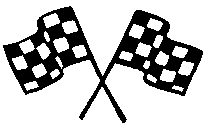 My Racing car
My Racing car

Welcome from sunny Australia!
 My Racing car
My Racing car
I have been racing this car since 1990, and it has changed quite a bit since then. The lap times have tumbled down quite a lot, mostly due to the improvements made to the chassis, engine, drive train, and suspension
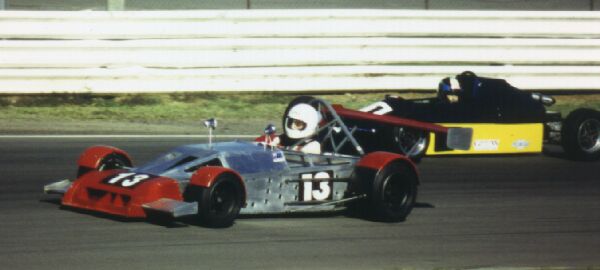
This
is me, passing a Formula Ford under
brakes at 'Hungry' corner, at Lakeside Raceway..
The car has run in a
few of the
Sports
1300 National Championships, and the results are -
-
1992, Eastern Creek. 3rd place
-
1993, Lakeside. Was running in 2nd place,
then the throttle cable broke.
-
1997, Wakefield Park. Qualified on pole,
but was just beaten so a very close 2nd place.
-
1999, Willowbank Raceway. 3rd place, with
a friend guest driving in my place. (work commitments)
-
2000, Eastern Creek. On pole position for
the race, but the diff blew on the line so a DNS.
-
2001, Willowbank Raceway. Qualified 5th on
the grid, but the gearbox failed in the previous race so I could not
compete.
-
2005, Willowbank Raceway.
Qualified 5th on the grid but did not start the first out of the three
races due to a minor engine problem. Did well in the other two to get
third. Was easily the fastest car in class though.
- 2006, Oran Park. Qualified 1st in class, 5th on the grid but on the
start line for the first race the gearbox broke and suspension also was
badly damaged.
- 2007, Morgan Park, gearbox again failed in practice.
- 2008, Oran Park, finally finished all three races got third in class.
A quick link to the -
-
Engine
-
Suspension
-
Brakes
-
Chassis
-
Wheels
& tyres
-
Gearbox
-
Tailshaft
&
differential
-
Thanks to
...
-
Some links
-
Some
motorsport jokes.
:)
Also please take the time to check out my New Racing Car. This one's going to be a lot faster, and this time it's not UgLy! :)
The
car
was the third one built buy Rick Choules, of Brisbane Australia, and
the last. Unfortunately soon after finishing the car Rick's back
& knees started to get very bad and so he couldn't drive it or
build another. I bought it off him in late 1988, and my Father
& I spent a year getting most of the 'fiddly' bit you need to
make a racing car work, such as the special pistons, head gasket, etc.
(The car itself was complete, but Rick hadn't got to build the race
engine before he sold it to me - It only had a standard road type with
all the external bits to
make it look like
a racing engine, at least!)
My first
outing could have
gone
a
lot better; The suspension was not set up at all and so was diabolical
to drive.
I spun halfway around a corner and clipped the gutter, damaging the
nose. (I
thought I could do a lot better because I had driven rally cars before
that,
so I reckoned a lot of the skills I'd learned off the road could have
been applied
on the track. Not so! It took me a number of years to get down to any
reasonable
sorts of lap
times.)
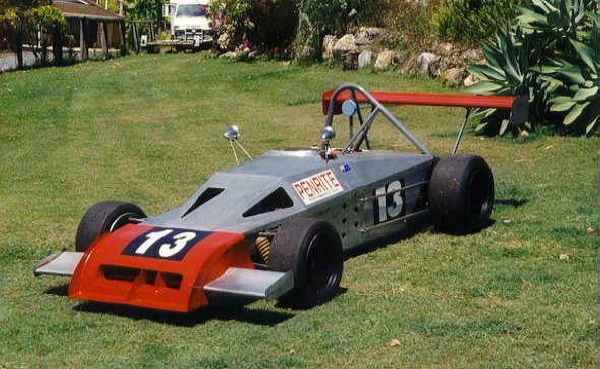
Through
the years the car has been developed so that is easy to drive 'on the
limit' and occasionally beyond! The last major rule change the class
had allowed
the cars to have wings front & rear, so to get the best out of
the car it
has a fixed angle pair of wings on the front and a variable (In the
pits only)
angle wing on the rear. These have helped the cornering speed and
stability noticeably.
The other area of interest in the car is the engine - At the moment it
a test
car for a proposed new type of engine, the current cars being
restricted to single
cam two valve 1300cc types. I have a Suzuki Swift GTi 1300cc 16 valve
twin cam
in it with only minimal modifications to let it make about 135 hp with
a rev
limit
of 8,000 rpm. The old style engines are usually Toyota
Corolla 3K 1200cc
engines with 4 mm oversize pistons to take them out to 1294cc, and many
other
mods to get the same amount of power from them. Another common engine
is the
Datsun 1200GX A12, which has similar mods. Both these engines are a
push-rod
over head valve type, and have problems with longevity running at the
8,000 -
9,000 rpm's they need to make
useful amounts of horse power.
So, the
proposal was to
introduce
a modern type twin cam engine with minimal & restricted
modifications to
make the same level of power with much greater
reliability and on-going costs.
The
(major) proposed
restrictions
for the engines are-
- A
compression limit of
10.25:1,
thus allowing the use of regular petrol station 'premium' unleaded
fuel. (The
older single cams needed around 13:1 compression to make good power,
and so had
to use high-octane aircraft fuel only
available at airports at great expense & effort)
- A rev
limit of 8,000 rpm.
Much
the
same as most of the small modern twin cams are as they come from the
factory
anyway.
- A
maximum cam duration of
about
270° and lift of 0.355".
**
The
Suzuki's were finally approved to run as of 1-1-99, so cheap racing is
back with
the Sports 1300's !
Ok,
to
the car.
The
engine is
almost as it came out of the road going car, the only mods that have
been done
to it are -
- A pair
of longer
duration & lift cams. (275°, 0.355" lift)
- A 'dry
sump' system has
been
fitted
to allow the oil system to continue to work even at the
~ 2 G's cornering & even higher braking forces that the car can
generate.
- A pair
of hand made free
flowing
manifolds for the inlet and exhaust systems.
- A pair
of 45mm Weber side
draft
carburettors fitted.
- A
lightweight alloy
flywheel,
clutch,
and clutch plate fitted, total weight of all three
6kgs. (13lbs)
The rest
of the engine is
fairly
standard,
ie, the valves, pistons, crank, block, head & ports, etc.
The
engine makes good power
at
all
revs and doesn't have the peaky torque curve of the current single cam
engines.
The other benefit is that we think that the twin cam engines will be
able to
be run from five to ten seasons before having to be rebuilt - The
current single
cam engines will only run from one to two seasons and still be
competitive. (And
are far more expensive to
rebuild!)
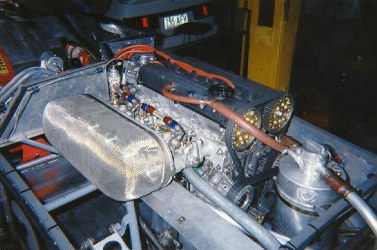
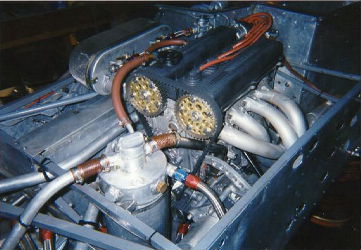
The
suspension at the front is a non-parallel unequal length double A-frame
type, with an anti-droop set-up & no front anti-roll bar, and a
Triumph Herald upright with Ford Cortina Mk1 brakes. The rear
suspension is a five link, with four trailing arms and an under-slung
Watts link under the Datsun 1000 Utility diff housing. Limited slip
diffs aren't allowed, so great attention has been taken to keep both
the rear wheels stuck firmly to the ground at all times. The rear
brakes are from a Honda Odyssey 'fun 4-wheel bike' thing. All of the
four adjustable rate shock absorbers have moveable spring platforms so
the ride height and roll centre height of the car can be altered. The
steering rack is from a Triumph 2000, as they have a very good
turn-to-rack motion ratio. (In fact, it's reckoned that more Triumph
racks are used in racing cars than in actual Triumph's!)
The
chassis is a hand made 'one off'. Rick Choules
made from 19mm (3/4") thin wall steel square tubing, with the alloy
panels glued
and riveted on to improve it's torsional rigidity. It has
an 82.5" wheelbase, a front track of 55", and a rear track of 52". The
wheelbase
is very short compared to the track and would normally have very
twitchy characteristics,
but it's actually fairly tame to drive on the limit and can be thrown
around
and corrected easily. The car complete, ready to race weighs 391kgs,
(862lbs)
but with my long, tall
body in it, it comes up to nearly 500kgs. (1100lbs)
That's
still very light for
a
Sports
1300 though, most cars being 40 - 60kgs heavier -
That's good.
I weigh
up around 100kgs
(220lbs)
and most of the other drivers weigh 20 - 30kgs less -
That's bad.
I'm also
a little cramped
for
room
in the car as it's wheelbase is only about 4" longer
than I am tall - 78" or 6'6" or nearly 2 metres. I guess I'm used to it
though
...
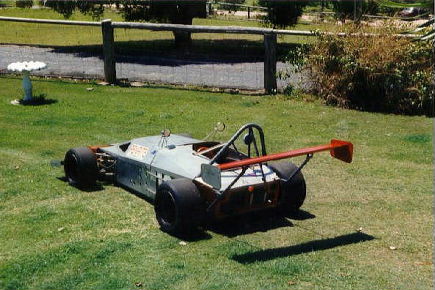
The wheels are a locally made 'spun alloy' three piece type. The fronts are 13x8", and the rears are 13x10.5". The tyres I use are Dunlop 195/490-13 on the front and 230/550-13 on the rear with both ends having the 271 compound, which is similar to what the Australian Formula Two racing cars use for wet weather tyre compounds. I run about 13psi in the front and 15psi in the rear for tyre pressures once the temperature has stabilised to normal running temps. The tyres can last as long as a season, but of course the faster you go the shorter they last. Some of our guys uses a set of fronts every two meetings!
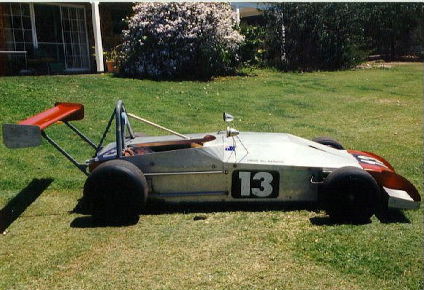
| The original pattern looked like this - | 1
3 5 | | | --------- | | | 2 4 R |
| But to get the ratios we wanted it ended up like this - | 2
4 1 | | | --------- | | | 3 5 R |
The
other
hassle was the gear selection mechanism. The original gearstick came
out of back of the extension housing, and its motion was transmitted to
the main selector fork shafts by another selector shaft between them.
Since the extension housing was shortened a great deal, it was decided
to cut another hole in the extension housing over the top of the main
selector fork shafts ends and have a new gearstick come straight down
into them directly. This was fairly easy to do, as all it involved
doing was cutting the hole, inverting the main selector fork shaft
ends, fabricating a new gearstick & mount, and also fabricating
the lock-out mechanism.
The
bottom of the gearbox
has a
large
audio heat sink grafted on to help dump the heat
into the airflow.
Complete,
without oil, the
gearbox
weighs about 23lbs.
We ended
up re-using only
the
gearstick knob off the old gearbox!
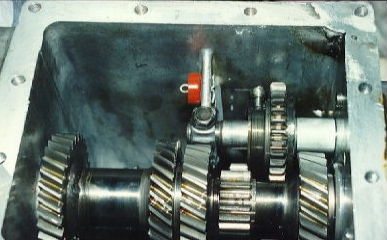
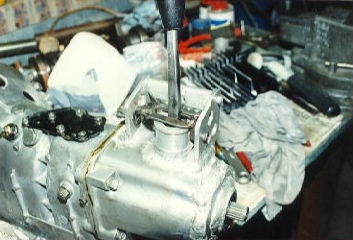
The diff housing was originally from a Datsun 1000 Utility, and has a alloy centre with a ratio of 4.111:1. We also have 4.3751 and 3.9:1 ratios if we ever need them. (3.9:1 is good for Eastern Creek, but 4.375:1 is good for Willowbank & Wakefield Park) The ends of the diff housing have large uprights welded onto them so the trailing links can attach and locate accurately. The Watts link sits under the diff and it's two arms go laterally to the sides of the chassis.
| The standard Datsun 1000 diff centre just isn't strong enough unfortunately, so we had to build a four-spider diff pretty much from scratch. Hopefully it'll be bulletproof ... and so far it has been. | 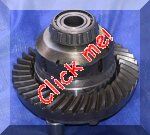 |
**
Slight
change to the above paragraph - I had an 'off' in the car in late 1999,
and we couldn't fix the nose in time, and it ended up being easier to
build a completely new one. Turned out to be a good idea, as it's a lot
lighter, perhaps a little more aerodynamic, and has about the same
downforce as
the old nose.
The
cynics say that it
certainly looks
better! :)
| Here's a picture of the car running around the Driver Training Center, at Norwell, on the Gold Coast. The new nose makes about the same downforce as the old one, despite having no wings. |  |
 |
Here's the racer at my first run atWillowbank raceway , west of Brisbane. Quite a slippery track and the car wasn't as fast as what I hoped it would be, but it still got very good results. |
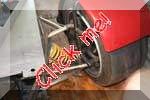 |
 |
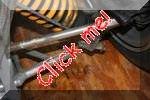 |
He's
not always of the best of health, so in
years gone past we've had a lot of help from a few people; Ron
Pomerell,
Rick Choules, and Adrian
Brooke.
Without
those guys & their special
talents & effort, the work would just not get done. Again, a
huge
thanks for their time.
There's also some
pictures of my New
Racing Car.
To see
more of the other
cars in
this
class, check out Martin's
Motorsport Page.
And
there's also a big Clubman
links page.
For
even more motorsport links, try the motorsport
section
on my links page.
On to Page Two, the car's rebirth
But wait!
There's more!!!
Top ten
reasons Racing is better
than
Sex:
10.
It’s socially acceptable to do it while
others watch.
9.
Bigger cars don’t always get the most
attention.
8.
The phone won’t ring in the middle of
your race.
7.
You get to use your rubber more than once.
6.
You don’t have to sit through dinner and
a movie before you race.
5.
You and the car always finish at the same
time.
4.
You always know where to put your hands.
3.
You can drive hard, right from the start.
2.
The quicker you finish, the better you
are.
1.
You can do it more than once in one
afternoon.
Back to the Index page
Page & contents where applicable © Bill Sherwood